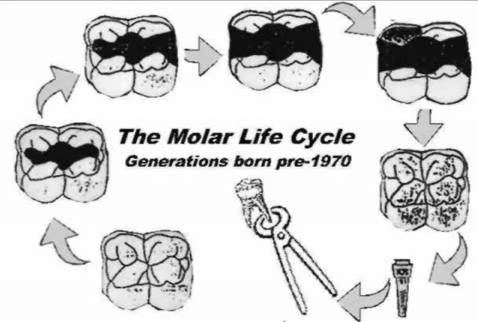Dental restorations or fillings are living in a very harsh environment. As I mentioned a couple of weeks ago, “The mouth is on a slippery downhill slide, the best that we can hope for is to make sure that it is not always slippery and that the slope is not steep.”
What this means is that although we might call a filling ‘Permanent’ it does not mean ‘lifelong’. Fillings are going to need to be replaced so matter how well they are done. Patients will chew on hard nuts and ice, they clench when they are stressed or just don’t take sufficient care of them. This means it is just a question of when they will fail.
Nowadays, the modern materials and cements are so strong that if things fail very soon after they are placed that it is usually our fault. Maybe the material was mixed wrong or you licked the tooth when we weren’t looking or we were just having a bad day. It happens. And we’ll fix it. But that’s not what I’m talking about.
Nature takes about 9 years to build a tooth. Unfortunately, bacteria that have evolved for millions of years are also around our teeth, and together with foods and drink and the stresses of everyday life, teeth decay or erode or crack. Many different materials have been used to restore teeth but let’s just call them white fillings (composite resin), silver fillings (amalgam) and porcelain fillings.
Studies have shown that a large white filling in a premolar has an 84% chance of surviving 12 years compared with about 75% chance for an amalgam filling. This is even higher in people considered to have a low caries risk. Porcelain restorations survived best of all and can last 20 years or more.
However, if we looked at fractured or cracked teeth there are between 5x to 50x more chance of an amalgam restoration being the cause versus a composite resin. The main reason is that teeth had to be prepared significantly more in the past when undercuts were required to retain the silver fillings.
For silver fillings, this is known as the Molar Life Cycle or the Circle of Death whereby a small filling –> medium filling –> large filling –> cracked tooth –> rebuilt tooth –> root treated tooth with post and crown –> extraction.
What this means is that because of the materials and equipment like the Diagnodent and dental laser, we can pick up fillings sooner, treat them earlier and more conservatively with composite or porcelain, meaning not only a longer life cycle for the filling but also your tooth. And surprisingly that also helps your hip pocket in the long run too.
So don’t be afraid to come in a have a checkup, even if it’s been a while. We are a Guilt-free office and we won’t give you a lecture. Take a look our Galleries to see what can be done with modern materials. You’ll be glad you did and you’ll be able to keep those pearly whites for a long time to come.


